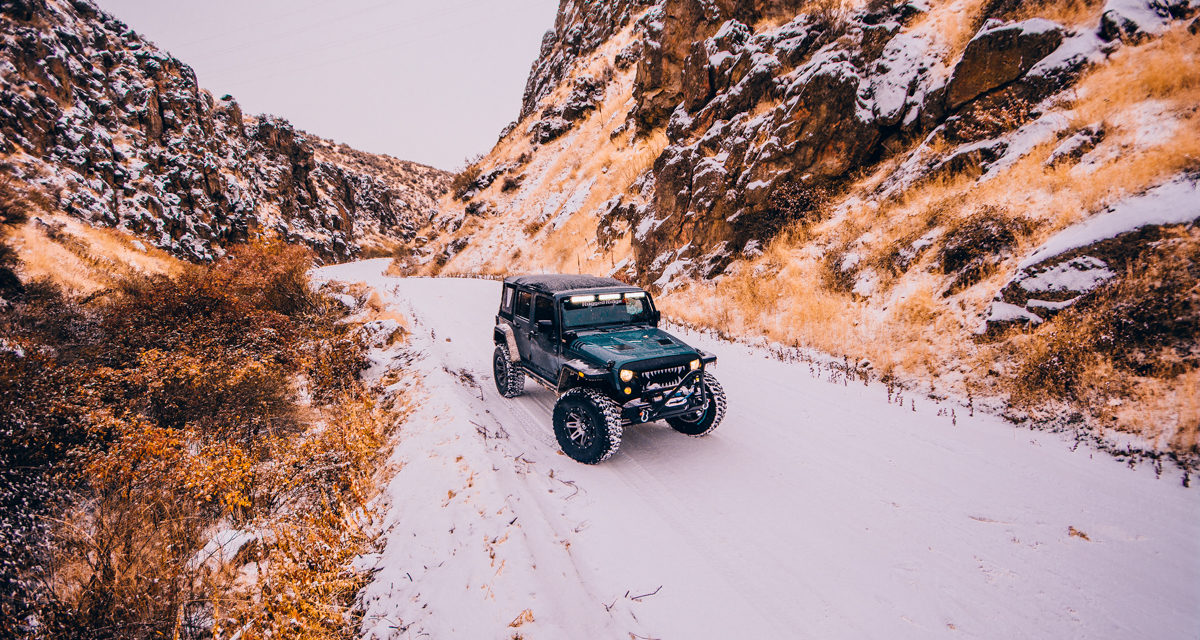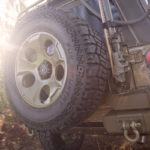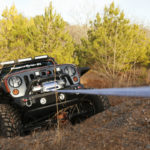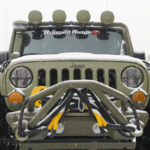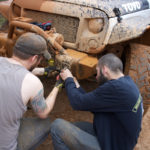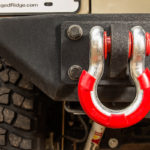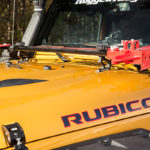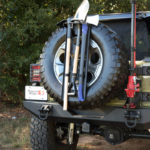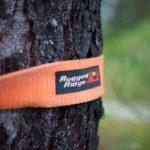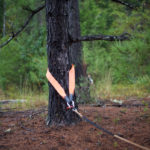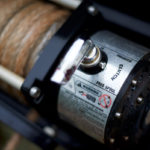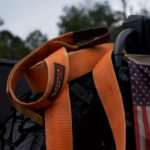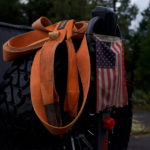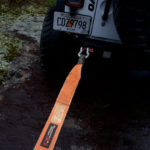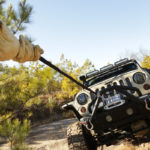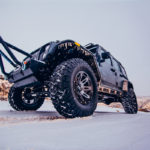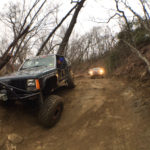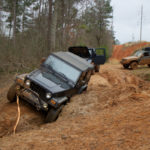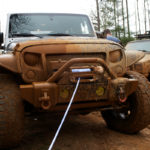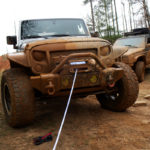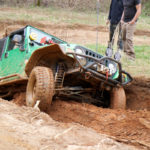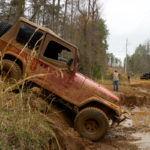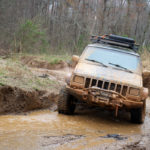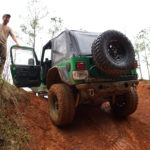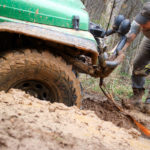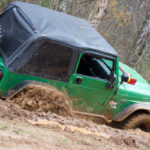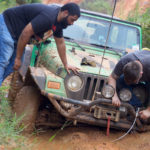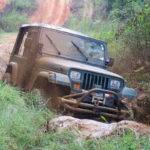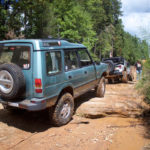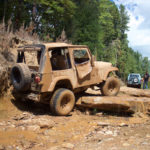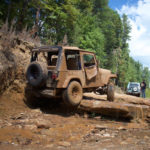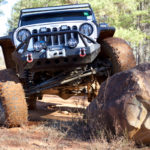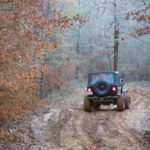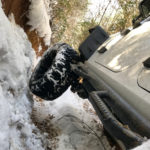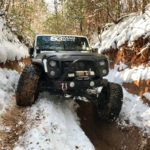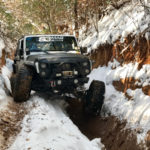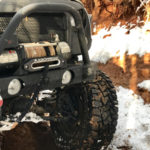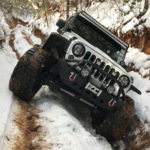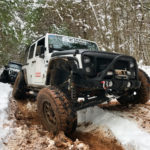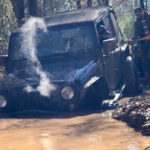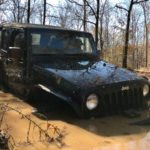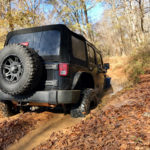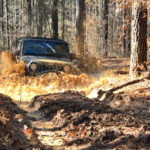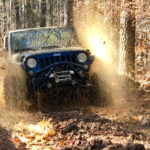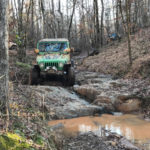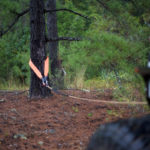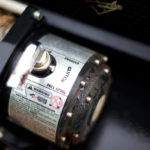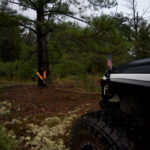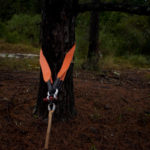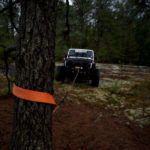Keep in mind before you embark on your adventure – that it may be a good idea to travel with someone who is already familiar with the trails. They can also serve the dual-purpose of helping you out of a bind if you get stuck. Usually getting stuck can be attributed to one of two problems: lack or ground clearance OR lack of traction.
Avoiding the ground clearance issue is usually pretty obvious – don’t drive over something higher than the bottom of your vehicle. But if you come up on an iffy situation, try to line up either the driver of passenger-side tires to drive directly over the obstacle. This will lift the side of your vehicle & increase your ground clearance. You’ll also generally have more clearance on the side of the vehicle, than you will under the belly & axles. If you straddle the obstacle, you may high-center, making it difficult to get unstuck if the obstacle is wedged under your vehicle.

Getting Unstuck
First, find out why you’re stuck. Did you drive over something too tall (lack or ground clearance)? Or, does the ground offer so little traction that your tires spin (lack of traction)?

Stuck because of ground clearance
-There are a few initial tricks when it comes to getting unstuck… and we have often found that simply stacking rocks to fill in holes and gaps may help lift your truck and level out the terrain. Or it may help you grab that little bit of traction that you need. Having said that, always be sure to scatter the rocks after you’re done to preserve the challenge for the next person. We don’t build roads when we’re wheeling.
-If you are only lightly resting on an obstacle, sometimes backing up slowly will work. In doing so, try to back up far enough to where you can see the trail again… to plan a different path.

-Or, you may decide to winch yourself off the obstacle in a slow, controlled manner. When you use a winch you have the benefit of being able to pull slowly, and stop when needed. Maybe you decide to stack more rocks under the tires and/or pull from a different direction. A winch is a great tool for getting unstuck without doing damage to the bottom of your 4×4.
-If you are badly stuck on an obstacle, you probably need to lift the vehicle off of whatever it is that is obstructing your path. Dragging the Jeep across the obstacle with a winch may do damage. So use a Hi-Lift jack and Lift Mate to raise the tires on one side of your vehicle off the ground. This may be a good time to stack rocks under the tires to increase your ground clearance by forming a ramp that will allow you to drive off the obstacle.
Keep in mind that your wheelbase will affect your ground clearance under the center of your Jeep. Short Jeeps (2 doors) have a higher “breakover angle” than longer Jeeps.
Stuck because no traction

When you’re dealing with a lack of traction situation, the key is to keep a slow/steady momentum. If you stop, you’ll usually get stuck. And though it seems natural in the moment… spinning the tires faster seldom works & will only dig you in deeper. (cutting the tires slightly back & forth while keeping slow/steady momentum will sometime catch a little extra traction).
The next thing to try is backing up in your own tire tracks, which will sometimes get you back to safe ground. Backing up usually works pretty well, especially in sand, because you are driving in your own compressed tracks. If this fails… take a break, and determine where you need to go, and how you plan to get there.
Start with some of the easy solutions to save your sanity. And then work your way down to the harder fixes if necessary:

- Shift into 4WD if you haven’t already. 4WD High will decrease the torque. Decreasing the torque makes it less likely that your tires will overpower the available traction. See if you can creep forward or backward. If you get any movement, try to keep a nice steady speed. Once you get going, keep going, until you reach firm ground.
- Air down the tires if you haven’t already. Letting some air out of the tires increases the tire’s footprint, and may provide enough grip to get you out. Remember that you probably need to drive on paved roads after you get out, so don’t go too low unless you have an air source. 12 to 15 psi may work.
- Sometimes, all you need is a gentle tug from your buddy with a recovery strap. Gentle is the key word here. Unless you’ve really buried your truck, a gentle tug from someone with grip usually works.

*Be sure to use a recovery strap rather than a tow strap. A recovery strap is slightly elastic and has sort of a bungee effect. A tow strap doesn’t stretch and can break & cause damage to your vehicle if pulled too hard. Never use a strap with metal hooks on the ends since the strap can break – causing the metal hook to become a projectile.
**Only hook-up to sturdy tow points. All tow hooks must be attached to the frame or a factory designated area. Even the unibody Jeeps have factory tow hooks attached to areas designed by the Jeep engineers.
***Do not pull on a trailer hitch ball. They will have a tendency to snap off and come flying back at you. But you can remove the drawbar from the hitch, insert the looped end of the strap and secure it with a hitch pin.

Hooking up the Winch

First, grab your gloves, a tree-saver strap, D-shackle, and the winch remote control.
Plug in the winch’s remote control, and wrap the remote control cord around the mirror to keep it away from the ground or tires… and hand it to the driver.
Then, determine which direction the Jeep needs to go in order to get unstuck.
Locate a large living tree or vehicle to use as an anchor point. The anchor point needs to be at least 2 or 3 Jeep-lengths away in order to pull the Jeep far enough forward to get unstuck.

Turn the lever on the winch to free-spool, and pull the winch line towards whatever you intend to use as an anchor.
When using a tree as an anchor, place the tree-saver strap around the tree trunk near the ground. This is the strongest part of the tree, and the least likely place to do damage to the tree’s bark.
Have the looped ends of the tree-saver strap facing the winch/Jeep. Remove the screw pin from the D-shackle, and push the shackle through the strap’s looped ends. The round part of the D-shackle needs to go through the strap’s eyes, leaving the pin available for the winch hook.
Screw the pin back in, finger tight. Then unscrew the pin ¼ turn to prevent it from binding.
Connect the winch hook to the shackle. Make sure the open part of the hook is facing up for safety.

Lay a winch line weight across the winch line, if you have one, and fill it with a little dirt/sand. The weight of the dirt/sand will absorb the energy if the winch line breaks, and the line will just fall to the ground instead of becoming a projectile. A hoodie or 2 will work if you don’t have a weight bag.
Then, go back to the winch, turn the handle back to engaged, and plug in the remote control.
Be sure everyone is well clear of the area. At least 150 feet away. FYI: The winch only has the advertised pull rating on the lowest layer of cable. And always leave at least 5-9 wraps on the drum so the line does not unwind from the drum. And never walk across or straddle a cable. Step on the winch line if you must cross over it.
Once the Jeep is unstuck, disconnect the winch hook from the tree-saver strap & D-shackle.
Next, use the remote control to respool the winch cable. Feed the winch-line in evenly from side-to-side on the drum (like fishing line). Always wrap the winch-line neatly on the drum to prevent binding. If a winch-line is pulled down in between the layer below, it will bind and you may not be able to unspool the cable next time you need it.
Finally, disconnect the remote control, and put all your stuff within easy reach in case you need it again.
Operate the winch periodically at home to keep the solenoids working properly.
Steel winch cable is abrasion resistant and cheap. But, it is heavy and therefore has more energy (whip) when it breaks. It also kinks, twists, and frays easily. Synthetic line is better if you have the option.
Winch rope is easily abraded and needs protection when rubbing on anything. It is more expensive too. But it is very light and is considered safer because it stores less energy and does not whip as much when it breaks.
You can also tie a knot in a winch rope that breaks and still have 80% of its original strength. Winch ropes can be spliced and repaired.
- Kilroy
- Offroad Jack Mounting Bracket; 07-17 Jeep Wrangler JK This offroad jack mounting bracket from Rugged Ride fits 07-17 Jeep Wrangler JK/JKU The only thing more important than having an off-road jack on your Jeep® is being able to access it when the need arises. That’s why we designed the Rugged Ridge® Off-Road Jack Hood Mounting Brackets to store your jack in a safe, secure place that is accessible to you, regardless of your vehicles positioning. We developed these jack mounts to be lightweight but sturdy by building them from high-strength 6061 T6 aluminum and finished them with a durable textured black powder coat to keep them looking great for years of intense trail duty. Your off-road jack is kept safely contained with large thumb screws (or optional locking thumbscrews) that can be easily removed and installed, even while wearing gloves. Unlike most hood-mounted jack brackets, Rugged Ridge Off-Road Jack Hood Mounting Brackets actually look great with a skeleton style design and laser-etched logo. Installation is a breeze with the included hardware and we’ve even included gaskets to protect your paints finish.
Comprehensive List of Equipment
Although it is pretty long, the thought of eliminating even one of these items could have an extremely negative effect on the outcome of your day on the trail.
Tire pressure gauge – (0-60 psi)
Air source to refill tires – CO2, air compressor, or travel with a friend who has one of these, etc.
Fire extinguisher
First Aid kit
Leather palmed work gloves – for stacking rocks or operating a winch
Plastic tarp to lie on when looking / working under truck
Common hand tools- screwdrivers, sockets, wrenches, BMFH, etc.
Fluid spill kit = kitty litter, trowel, trash bag
High quality, long jumper cables or a Jump Box
Spare tire – full size
Tire plug kit
Roll of quarters for gas station air pumps, car wash, etc.
Lug wrench with correct size socket
Special socket for locking lug nuts
Spare lug nuts (2-3)
Hi-Lift jack (lubricated and in good working order)
Inexpensive rain suit & rubber boots
Hand cleaner, paper towels, shop rags
Tablet and pen(s)/pencil
Flashlight and extra batteries
Cell phone and 12 volt travel charger
High quality CB, cable, and antenna
FRS radios and extra batteries – because they’re portable
High quality tow hooks or attachment points front and rear, bolted with Grade 8 bolts
2in X 30ft recovery strap with sewn eyes and two 3/4 inch D-shackles (3in X 30ft for 4 door models)
If you have a winch; bring the winch controller, leather palm gloves, a tree saver strap, and 3/4 inch D-shackles
Small folding shovel
Bow saw for cutting tree limbs
- Kilroy
- Offroad Jack Mounting Bracket; 07-17 Jeep Wrangler JK This offroad jack mounting bracket from Rugged Ride fits 07-17 Jeep Wrangler JK/JKU The only thing more important than having an off-road jack on your Jeep® is being able to access it when the need arises. That’s why we designed the Rugged Ridge® Off-Road Jack Hood Mounting Brackets to store your jack in a safe, secure place that is accessible to you, regardless of your vehicles positioning. We developed these jack mounts to be lightweight but sturdy by building them from high-strength 6061 T6 aluminum and finished them with a durable textured black powder coat to keep them looking great for years of intense trail duty. Your off-road jack is kept safely contained with large thumb screws (or optional locking thumbscrews) that can be easily removed and installed, even while wearing gloves. Unlike most hood-mounted jack brackets, Rugged Ridge Off-Road Jack Hood Mounting Brackets actually look great with a skeleton style design and laser-etched logo. Installation is a breeze with the included hardware and we’ve even included gaskets to protect your paints finish.

